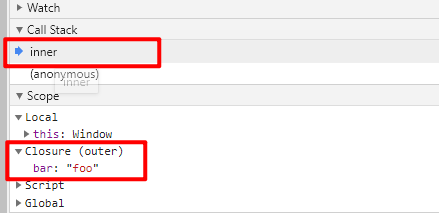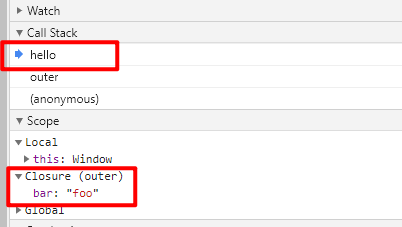何为闭包
一个函数包裹另一个函数,被包裹的函数成为闭包函数,外部函数为闭包函数提供了一个闭包作用域???
基本案例
function outer() {
let bar = 'foo'
function inner() {
debugger
console.log(bar) // 闭包函数用到了外部函数的变量bar
}
return inner
}
let foo = outer() // 执行外部函数返回内部函数
foo() // 执行内部函数所以,闭包函数必须要被外部变量持有???
例二
function outer() {
let bar = 'foo'
function inner() {
debugger
console.log(bar)
}
inner() // 直接在外部函数中执行了闭包函数inner
}
outer()
所以,被包裹的闭包函数是否被外部变量持有并不是形成闭包的条件
例三
function outer() {
let bar = 'foo'
function inner() {
console.log(bar)
}
function hello() {
// hello没有使用外部outer函数的变量
debugger
}
hello()
}
outer()
依旧形成了闭包,因为闭包作用域是内部所有闭包函数共享的,只要有一个内部函数使用到了外部函数的变量即可形成闭包
所以形成闭包的条件: 存在内部函数使用外部函数中定义的变量
应用场景
防抖和节流
见具体文章https://segmentfault.com/a/11...
给元素伪数组添加事件
let li = document.querySelectorAll('li');
for(var i = 0; i < li.length; i++) {
(function(i){
li[i].onclick = function() {
alert(i);
}
})(i)
}柯里化
概念:把接受多个参数的函数变换成接受单一参数的函数,并且返回接受余下的参数而且返回结果的新函数的技术
function currying(fn,...res1) {
return function(...res2) {
return fn.apply(null, res1.concat(res2))
}
}
function sayHello(name, age, fruit) {
console.log(console.log(`我叫 ${name},我 ${age} 岁了, 我喜欢吃 ${fruit}`))
}
const curryingShowMsg1 = currying(sayHello, '小明')
curryingShowMsg1(22, '苹果') // 我叫 小明,我 22 岁了, 我喜欢吃 苹果高级柯里化函数
function curryingHelper(fn, len) {
const length = len || fn.length // 第一遍运行length是函数fn一共需要的参数个数,以后是剩余所需要的参数个数
return function(...rest) {
return rest.length >= length // 检查是否传入了fn所需足够的参数
? fn.apply(this, rest)
: curryingHelper(currying.apply(this, [fn].concat(rest)), length - rest.length) // 在通用currying函数基础上
}
}
function sayHello(name, age, fruit) { console.log(`我叫 ${name},我 ${age} 岁了, 我喜欢吃 ${fruit}`) }
const betterShowMsg = curryingHelper(sayHello)
betterShowMsg('小衰', 20, '西瓜') // 我叫 小衰,我 20 岁了, 我喜欢吃 西瓜
betterShowMsg('小猪')(25, '南瓜') // 我叫 小猪,我 25 岁了, 我喜欢吃 南瓜
betterShowMsg('小明', 22)('倭瓜') // 我叫 小明,我 22 岁了, 我喜欢吃 倭瓜
betterShowMsg('小拽')(28)('冬瓜') // 我叫 小拽,我 28 岁了, 我喜欢吃 冬瓜缺点
可能会引起内存泄露,具体见https://segmentfault.com/a/11...


**粗体** _斜体_ [链接](http://example.com) `代码` - 列表 > 引用。你还可以使用@来通知其他用户。